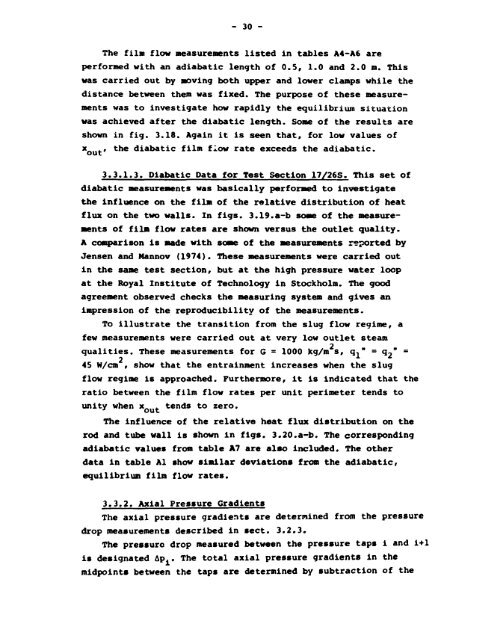An Experimental and Theoretical £ Investigation of Annular Steam ...
An Experimental and Theoretical £ Investigation of Annular Steam ...
An Experimental and Theoretical £ Investigation of Annular Steam ...
Create successful ePaper yourself
Turn your PDF publications into a flip-book with our unique Google optimized e-Paper software.
- 30 -<br />
The film flow measurements listed in tables A4-A6 are<br />
performed with an adiabatic length <strong>of</strong> 0.5, 1.0 <strong>and</strong> 2.0 m. This<br />
was carried out by moving both upper <strong>and</strong> lower clamps while the<br />
distance between them was fixed. The purpose <strong>of</strong> these measurements<br />
was to investigate how rapidly the equilibrium situation<br />
was achieved after the diabatic length. Some <strong>of</strong> the results are<br />
shown in fig. 3.18. Again it is seen that, for low values <strong>of</strong><br />
x , the diabatic film flow rate exceeds the adiabatic.<br />
3.3.1.3. Diabatic Data for Test Section 17/26S. This set <strong>of</strong><br />
diabatic measurements was basically performed to investigate<br />
the influence on the film <strong>of</strong> the relative distribution <strong>of</strong> heat<br />
flux on the two walls. In figs. 3.19.a-b some <strong>of</strong> the measurements<br />
<strong>of</strong> film flow rates are shown versus the outlet quality.<br />
A comparison is made with some <strong>of</strong> the measurements reported by<br />
Jensen <strong>and</strong> Mannov (1974). These measurements were carried out<br />
in the same test section, but at the high pressure water loop<br />
at the Royal Institute <strong>of</strong> Technology in Stockholm. The good<br />
agreement observed checks the measuring system <strong>and</strong> gives an<br />
impression <strong>of</strong> the reproducibility <strong>of</strong> the measurements.<br />
To illustrate the transition from the slug flow regime, a<br />
few measurements were carried out at very low outlet steam<br />
2<br />
qualities. These measurements for G = 1000 kg/m s, q," = q-" =<br />
45 H/cm , show that the entrainment increases when the slug<br />
flow regime is approached. Furthermore, it is indicated that the<br />
ratio between the film flow rates per unit perimeter tends to<br />
unity when x. tends to zero.<br />
The influence <strong>of</strong> the relative heat flux distribution on the<br />
rod <strong>and</strong> tube wall is shown in figs. 3.20.a-b. The corresponding<br />
adiabatic values from table A7 are also included. The other<br />
data in table Al show similar deviations from the adiabatic,<br />
equilibrium film flow rates.<br />
3.3.2. Axial Pressure Gradients<br />
The axial pressure gradients are determined from the pressure<br />
drop measurements described in sect. 3.2.3.<br />
The pressure drop measured between the pressure taps 1 <strong>and</strong> i+1<br />
is designated Ap.. The total axial pressure gradients in the<br />
midpoints between the taps are determined by subtraction <strong>of</strong> the
















